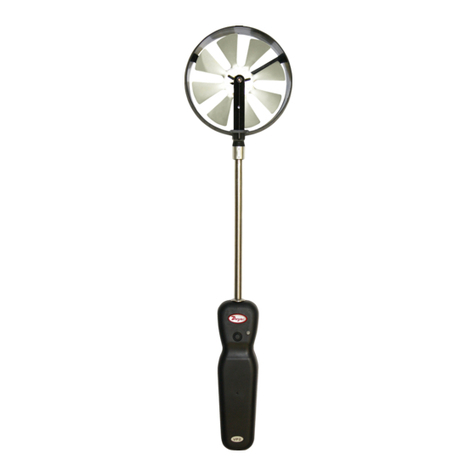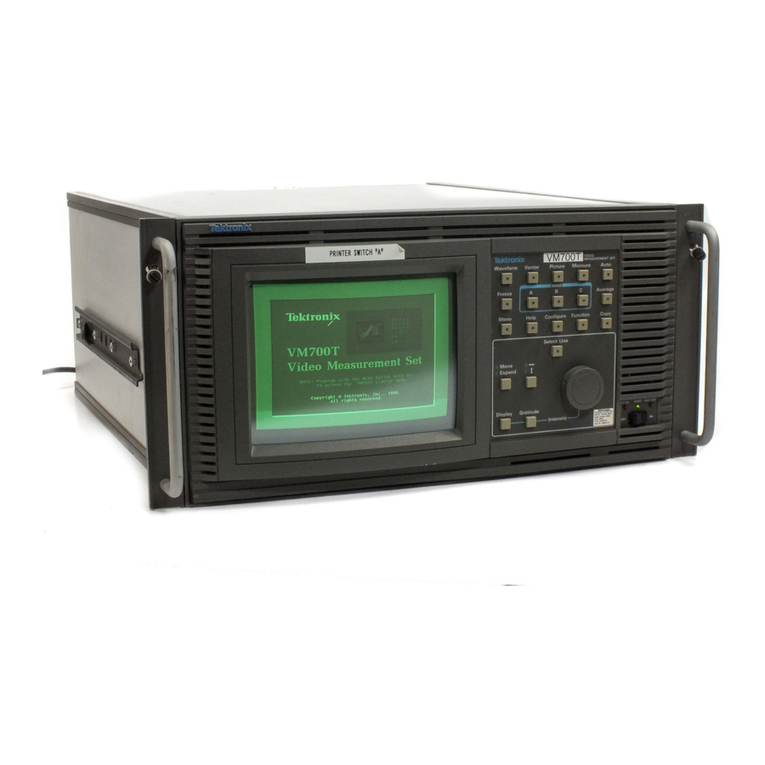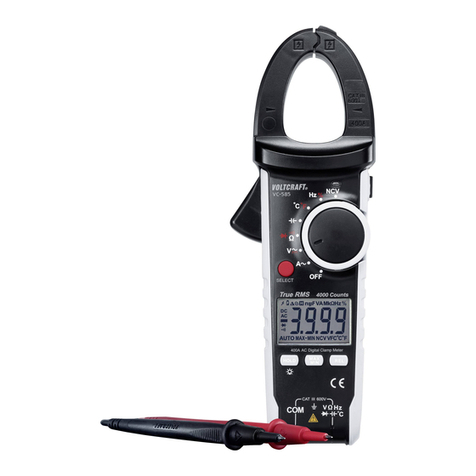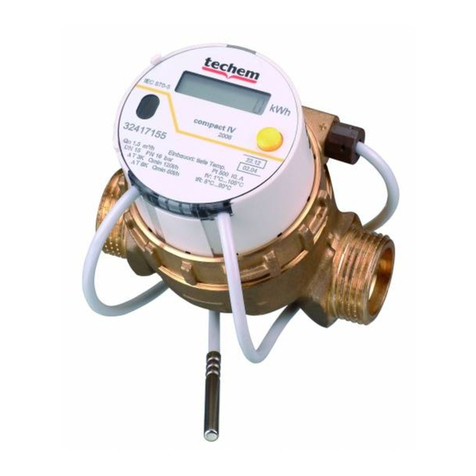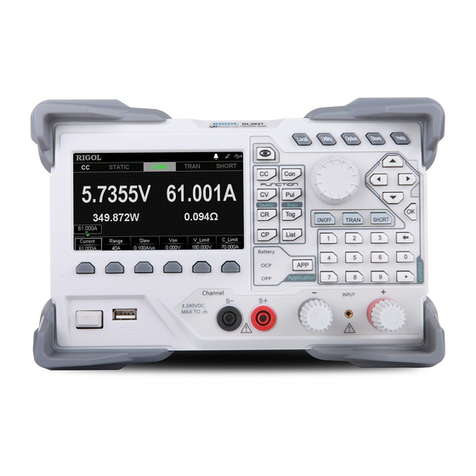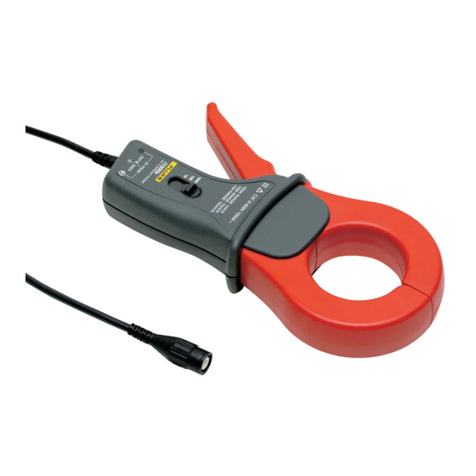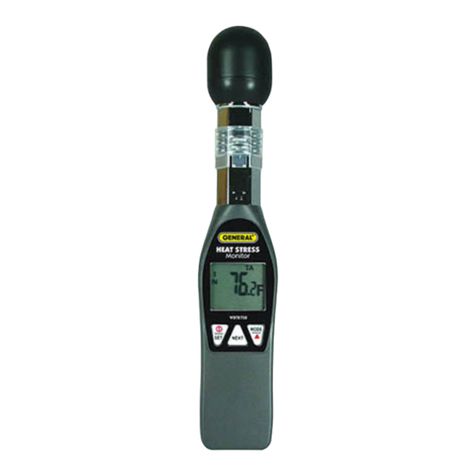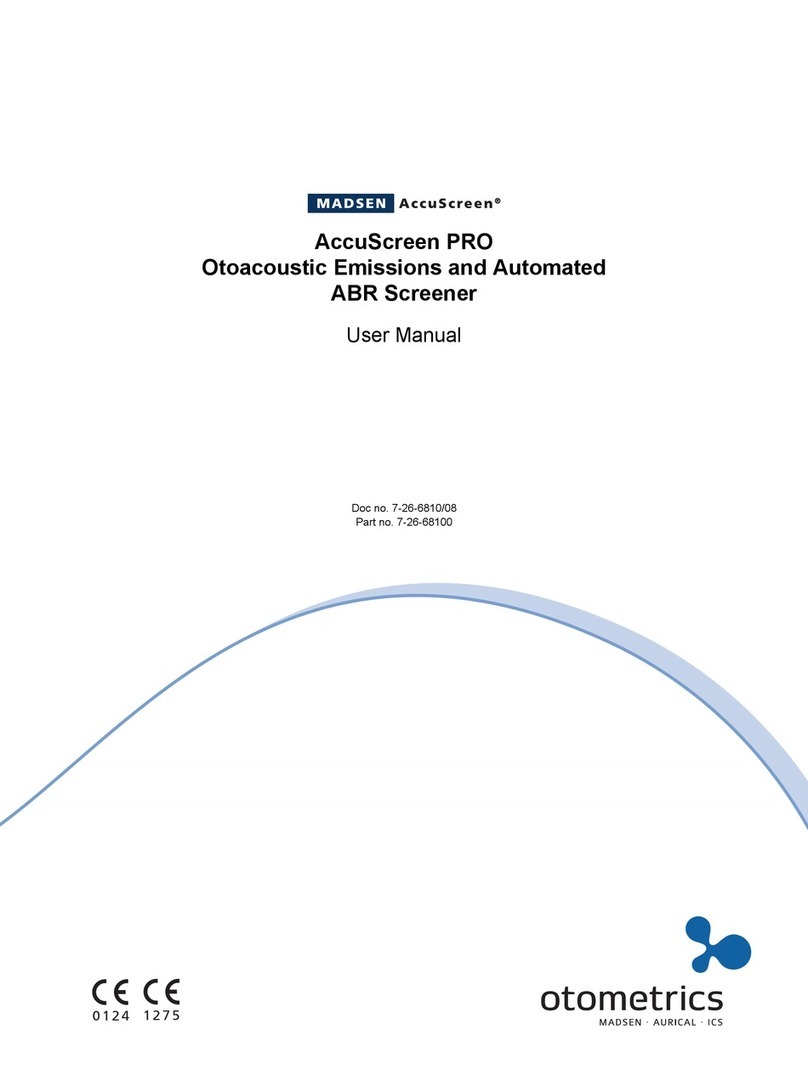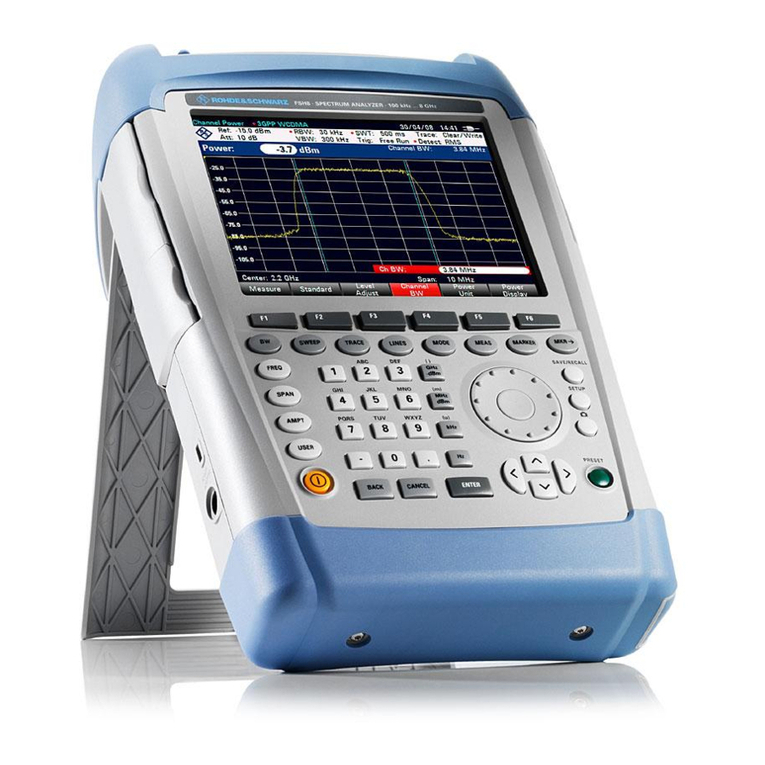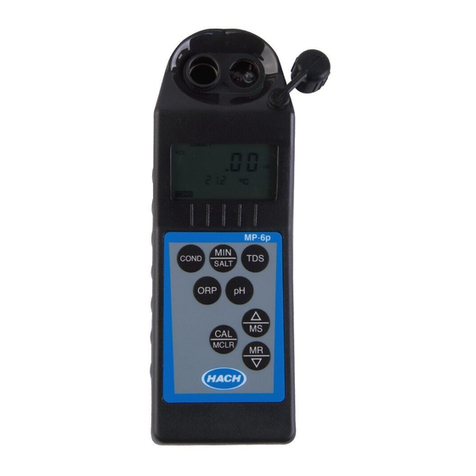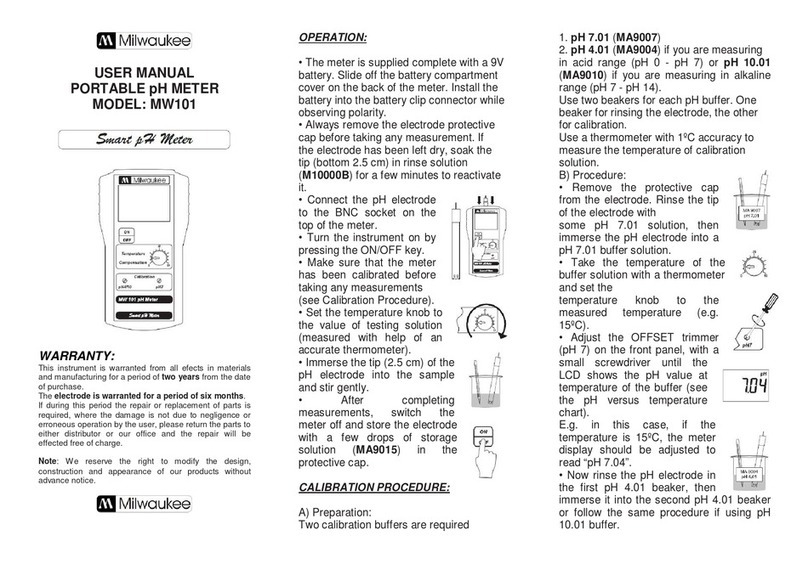enviromental express oakton PD250 User manual

PD250
PD260
pH/ORP/DISSOLVED OXYGEN METER


I
CODE:M003812-3200828209-GZ0000581083
November,2019 © 2019 Oakton Instruments.
• Preface
This manual describes the operation of the following instrument.
Be sure to read this manual before using the product to ensure proper and safe operation of
the product. Also, safely store the manual so it is readily available whenever necessary.
Product specifications and appearance, as well as the contents of this manual are subject to
change without notice.
• Warranty and responsibility
Oakton Instruments. warrants that the product shall be free from defects in material and
workmanship and agrees to repair or replace free of charge, at option of Oakton Instruments.,
any malfunctioned or damaged product attributable to responsibility of Oakton Instruments. for
a period of Three (3) years from the delivery unless otherwise agreed in a written statement. In
any one of the following cases, none of the warranties set forth herein shall be extended:
• Any malfunction or damage attributable to improper operation
• Any malfunction attributable to repair or modification by any person not authorized by Oak-
ton Instruments.
• Any malfunction or damage attributable to the use in an environment not specified in this
manual
• Any malfunction or damage attributable to violation of the instructions in this manual or
operations in the manner not specified in this manual
• Any malfunction or damage attributable to any cause or causes beyond the reasonable
control of Oakton Instruments. such as natural disasters
• Any deterioration in appearance attributable to corrosion, rust, and so on
• Replacement of consumables
OAKTON INSTRUMENTS. SHALL NOT BE LIABLE FOR ANY DAMAGES RESULTING
FROM ANY MALFUNCTIONS OF THE PRODUCT, ANY ERASURE OF DATA, OR ANY
OTHER USES OF THE PRODUCT.
• Trademarks
• Microsoft, Windows, Windows Vista are registered trademarks or trademarks of Microsoft
Corporation in the United States and other countries.
Other company names and brand names are either registered trademarks or trademarks of the
respective companies. (R), (TM) symbols may be omitted in this manual.
Brand: OAKTON
Series name: OAKTON 200 Series Handheld Water Quality Meter
Model: PD250, PD260
Model description: pH/ORP/Dissolved Oxygen Meter

Regulations
II
• Regulations
• EU regulations
• Conformable standards
This equipment conforms to the following standards:
Warning: This product is not intended for use in industrial environments. In an
industrial environment, electromagnetic environmental effects may
cause the incorrect performance of the product in which case the
user may be required to take adequate measures.
• Information on disposal of electrical and electronic equipment and disposal
of batteries and accumulators
The crossed out wheeled bin symbol with underbar shown on the product or accompanying
documents indicates the product requires appropriate treatment, collection and recycle for
waste electrical and electronic equipment (WEEE) under the Directive 2012/19/EU, and/or
waste batteries and accumulators under the Directive 2006/66/EC in the European Union.
The symbol might be put with one of the chemical symbols below. In this case, it satisfies
the requirements of the Directive 2006/66/EC for the object chemical. This product should not
be disposed of unsorted household waste. Your correct disposal of WEEE, waste batteries and
accumulators will contribute to reducing wasteful consumption of natural resources, and
protecting human health and the environment from potential negative effects caused by
hazardous substance in products.
Contact your supplier for information on applicable disposal methods.
EMC: EN61326-1
Class B, Basic electromagnetic environment
RoHS: EN50581
9. Monitoring and control instruments

Regulations
III
• Authorised representative in EU
Cole-Parmer UK
9 Orion Court, Ambuscade Road
Colmworth Business Park
St Neots
Cambridgeshire
PE19 8YX, United Kingdom
Phone: +44-(0)1480-272279
Fax: +44-(0)1480-212111
• FCC rules
FCC Compliance Statement
This device complies with part 15 of the FCC Rules. Operation is subject to the following two
conditions: (1) This device may not cause harmful interference, and (2) this device must accept
any interference received, including interference that may cause undesired operation.
Responsible Party for FCC matter
Oakton Instruments
625 East Bunker Court,
Vernon Hills, IL, 60061, USA
Tel: 1-888-462-5866
Note
This equipment has been tested and found to comply with the limits for a Class A digital device,
pursuant to part 15 of the FCC Rules. These limits are designed to provide reasonable
protection against harmful interference when the equipment is operated in a commercial
environment. This equipment generates, uses, and can radiate radio frequency energy and, if
not installed and used in accordance with the instruction manual, may cause harmful
interference to radio communications. Operation of this equipment in a residential area is likely
to cause harmful interference in which case the user will be required to correct the interference
at his own expense.
Any changes or modifications not expressly approved by the party responsible for compliance
could void the user's authority to operate the equipment.

For Your Safety
VI
• For Your Safety
• Hazard classification and warning symbols
Warning messages are described in the following manner. Read the messages and follow the
instructions carefully.
• Hazard classification
• Warning symbols
This indicates an imminently hazardous situation which, if not
avoided, will result in death or serious injury. This is to be
limited to the most extreme situations.
This indicates a potentially hazardous situation which, if not
avoided, could result in death or serious injury.
This indicates a potentially hazardous situation which, if not
avoided, may result in minor or moderate injury. It may also
be used to alert against unsafe practices.
Description of what should be done, or what should be
followed.
Description of what should never be done, or what is
prohibited.

For Your Safety
VII
• Safety precautions
This section provides precautions for using the product safely and correctly and to prevent
injury and damage. The terms of DANGER, WARNING, and CAUTION indicate the degree of
immanency and hazardous situation. Read the precautions carefully as it contains important
safety messages.
• Instrument and electrode
Do not disassemble or modify the instrument. Otherwise, it may heat up or be ignited
resulting in a fire or an accident.
Harmful chemicals
Some electrodes are used with hazardous standard solutions. Handle them with care.
The internal solution of pH electrode is highly concentrated potassium chloride (3.33
mol/L KCl) and internal solution of DO electrode is highly concentrated potassium
hydroxide (KOH). If the internal solution comes in contact with the skin, wash it off
immediately. If it gets into the eyes, flush with plenty of water and then consult a
doctor.
Broken glass
Broken glass may cause injury. The outer tube and tip of an electrode are made of
glass. Handle them with care.
Do not use the phono jack under wet or humid conditions. Otherwise, it may cause a
fire, electric shock, or breakage.

For Your Safety
VIII
• Battery
Keep batteries out of reach of children. If someone accidentally swallows a battery,
consult a doctor immediately.
If alkaline fluid from a battery gets into the eyes, do not rub the eyes, rinse with clean
water immediately and then consult a doctor. Contact with alkaline fluid could cause
blindness.
Do not put batteries in a fire, expose to heat, disassemble or remodel.
Doing so can case fluid leakage, overheating or explosion.

Product Handling Information
IX
• Product Handling Information
• Operational precautions (instrument)
• Only use the product including accessories for their intended purpose.
• Do not drop or physically impact the instrument.
• The instrument is made of solvent-resistant materials but that does not mean it is resistant
to all chemicals. Do not expose the instrument in strong acid or alkali solution, or wipe with
such solution.
• If the instrument is dropped into water or gets wet, wipe it using soft cloth. Do not heat to
dry it.
• The instrument has a dust-proof and waterproof structure i.e., the instrument does not
malfunction even when immersed in water of 1 m depth for 30 minutes. This does
guarantee non-destructive, trouble-free, dust-proof, and waterproof performance in all
situations.
• When replacing the batteries or when a serial cable connected, the instrument does not
have the dust-proof and waterproof performance. The dust-proof and waterproof
performance is maintained only when the covers are attached correctly.
• After replacing the batteries or removing the serial cable connected, make sure that the
waterproof gasket attached to the cover is not deformed or discolored, or has foreign
matter adhering to it. If the waterproof gasket is deformed, discolored or has foreign matter
adhering to it, dust could get inside, water leaks could occur that could lead to instrument
malfunction.
• To disconnect an electrode or serial cable, hold the connector and pull it off. If you pull at
the cable, it may cause breakage.
• The phono jack communication between the instrument and a personal computer (referred
to as PC in the rest of this document) may fail because of environmental conditions, such
as electromagnetic noise.
• Do not replace the batteries in a dusty place or with wet hands. Dust or moisture could get
inside the instrument, possibly causing instrument malfunction.
• Do not use an object with a sharp end to press the keys.
• If the power supply is interrupted while measurement data is being saved in the instrument,
the data could be corrupted.
• A NiMH rechargeable battery can be used in this instrument.
• Operational precautions (battery)
• Do not short circuit a battery.
• Position the + and side of the battery correctly.
• When the battery has depleted or the instrument will not be used for a long time, remove
the batteries.
• Of the specified battery types, make sure to use two batteries of the same type.
• Do not use a new battery together with a used battery.
• Do not use a fully charged nickel-metal hydride battery together with a partially charged
battery.
• Do not attempt to charge a non-rechargeable battery.

Product Handling Information
X
• Environmental conditions for use and storage
• Temperature: 0 °C to 45 °C
• Humidity: under 80% relative humidity and free from condensation
• Avoid the following conditions:
• Strong vibration
• Direct sunlight
• Corrosive gas environment
• Locations close to an air-conditioner
• Direct wind
• Transportation
When transporting the instrument, repackage it in the original package box. Otherwise, it may
cause instrument damage.
• Disposal
• Standard solution used for the calibration must be under neutralized before the disposal.
• When disposing of the product, follow the related laws and regulations of your country for
disposal of the product.

Contents
XI
■Product Overview ............................................................. 1
●Package Content........................................................ 1
●Key Features .............................................................. 2
●Product components................................................. 3
■Basic operations ............................................................... 7
●Mode and measurement............................................ 9
■Calibration ....................................................................... 11
●pH Calibration ...........................................................11
●ORP/mV Calibration................................................. 13
●DO Calibration.......................................................... 15
●Temperature Calibration ......................................... 21
■Data .................................................................................. 23
●Data capture and storage........................................ 23
●Data transfer............................................................. 24
■Setup ................................................................................ 25
●P1 pH setup .............................................................. 25
●P1 DO setup ............................................................. 29
●P2 Data setup ........................................................... 33
●P3 General setup ..................................................... 40
●P4 CLK setup ........................................................... 49
■Maintenance and storage .............................................. 54
●Maintenance and storage of the instrument ......... 54

Contents
XII
●Maintenance and storage of electrodes ............... 55
■Error messages and trouble shooting .......................... 57
■Appendix ......................................................................... 62
●Appendix 1 ............................................................... 62
●Appendix 2 ............................................................... 65
●Appendix 3 ............................................................... 70

Product overview
1
■Product Overview
This section describes the package content, key features and product components of OAKTON
PD200 series Handheld meters.
●Package Content
After opening the carry case, remove the meter and check for damage on the instrument and
confirm that the standard accessories all exist. If damage or defects are found on the product,
contact your dealer.
OAKTON PD200 series Handheld meters and meter kit include the following items:
S.NO. Name
1 Instrument
2 Instruction manual
3 2 AA batteries
4 Electrodes (Electrodes kit only)
5 Calibrating solutions
1
2
35
4

Product overview
2
●Key Features
• IP67 water ingress, dust-proof, shock-resistant, anti-slip meter housing.
• Large monochrome LCD (50 x 50 mm) with white LED back lighting.
• Built-in electrode holder (up to 2 electrodes).
• Foldable meter stand.
• Simple user interface and single parameter display.
• 500 (for PD250) / 1000 (for PD260) data memory.
• Automatic Temperature Compensation (ATC) with temperature calibration.
• Adjustable auto shut-off time (1 to 30 minutes).
• Auto-hold / Auto stable / Real-time measurement modes with stability indicator.
• Powered by 2 x AA batteries.
• Real-time clock (only for PD260).
• PC (standard USB) / Printer (25 pin serial) connection via 2.5 mm diameter phono jack.

Product overview
3
●Product components
No Name Function
1 Monochrome LCD Displays the measured value
2 Operation keys Used for instrument operation
3 Electrode connector Connect to the BNC connector of the electrode
4 Temperature connector (T) Connect to the temperature sensor of the electrode
5 Battery cover Open/close to insert/remove batteries
6 Electrode holder Hold the electrode to carry with the instrument
7 Meter stand Open stand to place the meter at an inclined position on a
flat surface
8 Serial connector Connects the serial cable and printer cable

Product overview
4
●Display
No Name Function
1 Status Icon Displays the current operation mode (Setup, Calibration,
Measurement and Data mode)
2 Parameters Displays the measured parameters like pH, RmV, and DO
3Stability indicator shows value is stable for documentation in
Auto Stable and Auto Hold modes
4Appears when the measured value display is stable and fixed in
auto-hold mode
5Temperature display
area Displays the measured temperature
6Measured value, set
item display area Displays the measured value and the set value
7
Indicates electrode sensitivity level
8Indicates error situation
9 Indicates data being transfered to the printer or computer
10 Displays the unit for the measurement parameter
11 Displays the battery level

Product overview
5
●Battery level display
●pH Electrode sensitivity level
100% battery life
50% battery life
20% battery life
Batteries are weak and need replacement. Refer “ BATT LOW ” (page 57) to
solve this
Electrode sensitivity above 95%(excellent)
Electrode sensitivity between 85% to 95% (very good)
Electrode sensitivity between 80% to 85%(good). Refer “ SLPE ERR ” (page
57) to solve this

Product overview
6
●Keypad operation
Keypad Name Function
CAL key Switches from the measurement mode to the calibration mode.
Starts calibration in the calibration mode.
MEAS key
Switches the operation mode to the measurement mode.
Releases the fixed measurement value mode in the auto hold
mode and begins a fresh measurement.
DATA key Switches from the measurement mode to the data mode.
MODE key In the measurement mode, changes measurement parameters.
SET key Switches from the measurement mode to the setup mode.
ENTER key Determines the selection or setup.
Saves data in the measurement mode and calibration mode.
UP key In the setup mode, navigates between various setups.
Selects preferred option in some setup screens.
Increases or decreases selected digit when entering numbers.
DOWN key
POWER key Powers ON/OFF the instrument.

Basic operations
7
■Basic operations
This section describes function and basic operation method of each part of OAKTON 200
series Handheld meters.
●Turning on the instrument
Inserting the batteries
This instrument is operated by batteries. You can use AA
alkaline batteries or AA Ni- MH chargeable batteries.
Perform the following procedure to insert batteries in the
instrument.
1. Unscrew the battery cover on the back of the
instrument counter-clock wise to unlock the bat-
tery cover.
2. Remove the battery cover and set the batteries
inside.
3. Replace battery cover.
4 . S c r e w t h e b a t t e r y c o v e r o n t h e b a c k
of the instrument clockwise to lock the battery
cover.
• Do not replace the batteries in a dusty place or with wet hands. Dust or moisture could get
inside the instrument and possibly cause an instrument malfunction.
• Do not short-circuit a battery.
• Note polarity as shown in the battery compartment.
• When the battery has depleted or the instrument is not used for a long time, remove the
batteries.
• Of the specified battery types, make sure to use two batteries of the same type.
• Do not use a new battery together with an used battery.
Note

Basic operations
8
●Connecting an electrode
To perform calibration/ measurement, it is necessary to use the appropriate electrode for
measurement parameter. Recommended electrodes for various sample are listed in our
product catalog. Use the following procedure to correctly connect the electrode to the
instrument:
1. Insert the electrode connector by fitting its groove with the connector pin of the
instrument (refer below table).
2. Turn the electrode connector clockwise by following the grooves.
3. Slide the connector cover on the connector.
4. When using a combination electrode equipped with a temperature sensor, insert the
temperature jack (T) to the ATC socket on the meter.
CH1 CH2
pH Electrode DO Electrode
Electrode connector
Temperature jack (T)
This manual suits for next models
1
Table of contents
Popular Measuring Instrument manuals by other brands
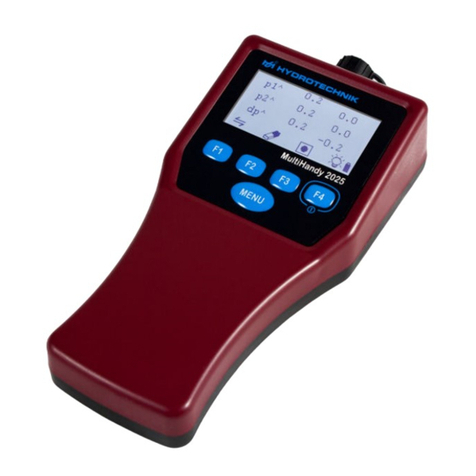
ICS Schneider Messtechnik
ICS Schneider Messtechnik HYDROTECHNIK MultiHandy 2025 operating instructions
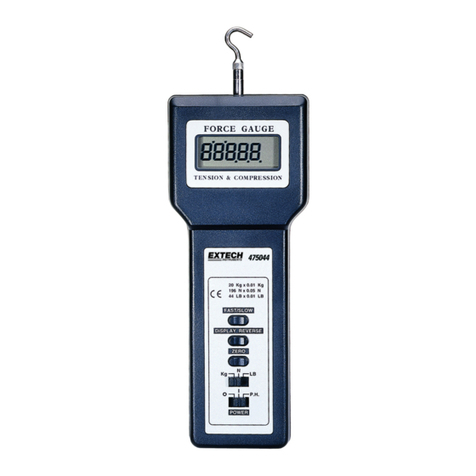
Extech Instruments
Extech Instruments 475040 user guide

Keysight
Keysight E4990A troubleshooting guide
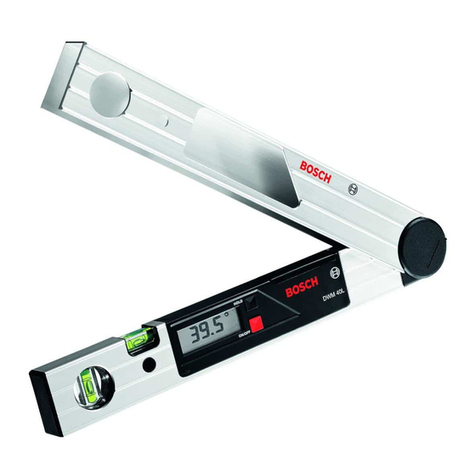
Bosch
Bosch DWM 40 L PROFESSIONAL operating instructions

horiba
horiba 9631-10D instruction manual
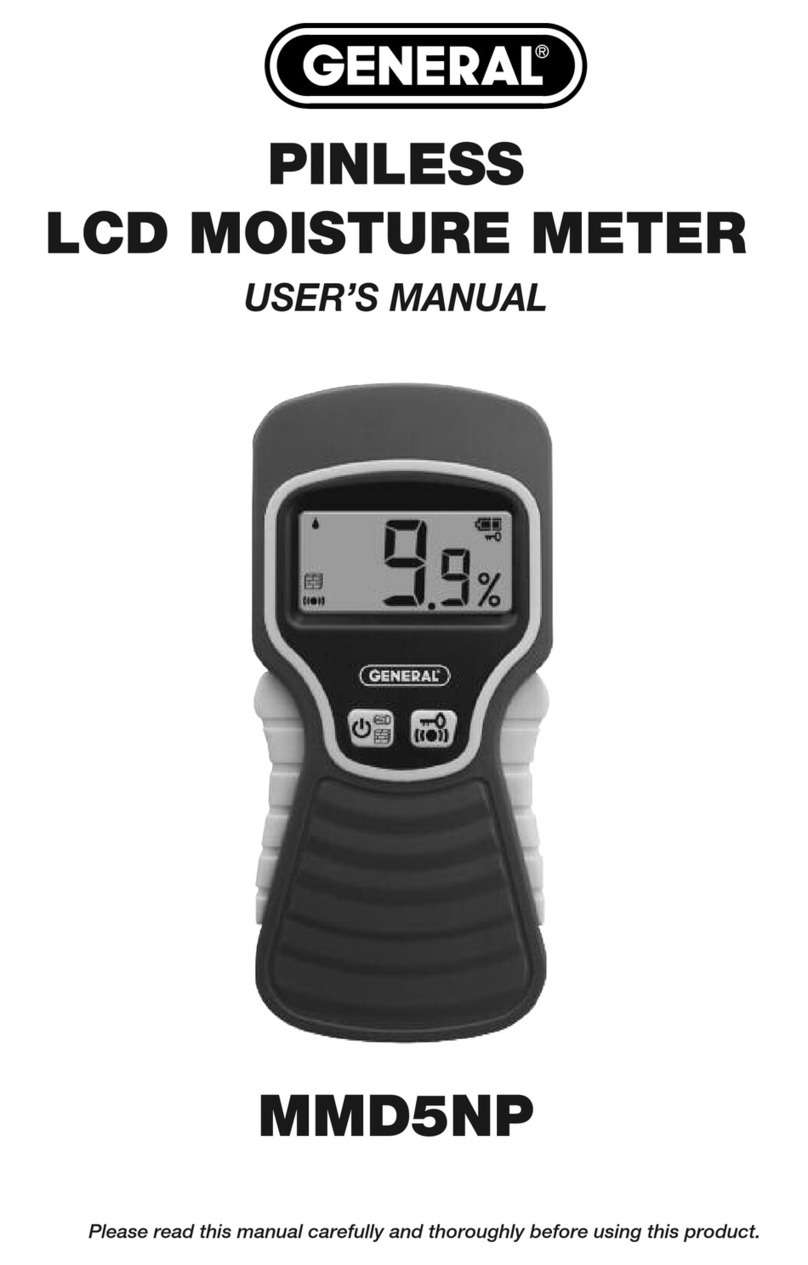
General
General MMD5NP user manual
